Assessment of the Suitability of Non-Air-Conditioned Historical Buildings for Artwork Conservation: Comparing the Microclimate Monitoring in Vasari Corridor and La Specola Museum in Florence
Abstract
1. Introduction
2. Materials and Methods
2.1. Methods
- (i.)
- (ii.)
- Comparison between the microclimate conditions monitored in the different considered buildings.
- (iii.)
- Analysis of the hygrothermal conditions and the climate adaptation in the heritage museum buildings to evaluate how construction characteristics influence the performance of the building and if non-air-conditioned historic building museums are suitable to properly preserve hygroscopic artworks.
2.2. Case Studies: Palazzo Vecchio–Palazzo Torrigiani Elevated Path
2.2.1. Vasari Corridor
- Ponte Vecchio, which crosses the river Arno with east–west orientation, characterized in the central part by the presence of large windows (geometric and construction details are reported in Table 1 and Table 2);The final part of the corridor, passing through the Florentine historical buildings, with few and small windows, being more protected from outdoor atmospheric conditions.
2.2.2. La Specola Museum
2.3. Monitoring Campaign
2.3.1. The Weather Data
2.3.2. Indoor Microclimate Monitoring Campaign of Vasari Corridor
2.3.3. Indoor Microclimate Monitoring Campaign of La Specola Museum
2.4. Data Analysis
- Average values over the selected period, i.e., monthly and yearly;
- Hourly values for defining the statistical limits included in the 93rd and seventh percentiles, to exclude the largest and riskiest fluctuations;
- Short-term fluctuations, i.e., 24 h.
3. Results and Discussion
3.1. Microclimate Monitoring of Vasari Corridor
Historical Climate of Vasari Corridor: Calculation of the Target Values for T and RH
3.2. Microclimate Monitoring of La Specola Museum
Historical Climate of La Specola: Calculation of the Target Values for T and RH
3.3. Comparison between Vasari Corridor and La Specola
- Room XXII (internal room, no external walls, with skylight): the average temperature difference is equal to 5.2 °C and decreases in the warm season (from April to September), while it shows peak values in the coldest months (January, February, and December). Indeed, the innermost position allows a notable buffering from the external cold climate, but provides less protection from summer radiation coming from the skylight and low chances of air exchange in the hottest months. The lowest values of temperature difference occur in late spring/mid-autumn, demonstrating that the effects of solar radiation coming from the unshielded skylight significantly influence the internal temperature.
- Room X (corner room with two external walls): the average temperature difference is equal to 3.2 °C and has almost flat trend from November to June, with values below the average, when the indoor temperature follows more closely the trend of the external temperature. On the contrary, the difference tends to increase and remain almost constant in the hottest months from July to October, when the room is shaded from the outdoor conditions (mainly solar radiation) even more than room XXII, because of the shielded windows.
- Lungarno—position A (small windows and southern orientation): the average temperature difference is equal to 2.8 °C and the trend is quite flat, probably due to the protection of the nearby buildings on the north side, except for a slight increase in September and October.
- Ponte Vecchio—position B (large windows and east–west orientation): the average temperature difference is equal to 2.9 °C, but its trend is in contrast with the previous zone. Indeed, starting from April, it increases until September and then decreases, reaching the lowest values, compared to all the zones in both buildings, in the coldest months (January, February, and December) to less than 1 °C.
4. Conclusions
Author Contributions
Funding
Institutional Review Board Statement
Acknowledgments
Conflicts of Interest
References
- Lucchi, E. Simplified assessment method for environmental and energy quality in museum buildings. Energy Build. 2016, 117, 216–229. [Google Scholar] [CrossRef]
- Silva, E.H.; Henriques, F.M.A. The impact of tourism on the conservation and IAQ of cultural heritage: The case of the Monastery of Jerónimos (Portugal). Build. Environ. 2021, 190, 107536. [Google Scholar] [CrossRef]
- Pedersoli, J.L., Jr.; Antomarchi, C.; Michalski, S. A Guide to Risk Management of Cultural Heritage; ICCROM: Sharjah, United Arab Emirates, 2016. [Google Scholar]
- Pisello, A.L.; Castaldo, V.L.; Piselli, C.; Cotana, F. Coupling artworks preservation constraints with visitors’ environmental satisfaction: Results from an indoor microclimate assessment procedure in a historical museum building in central Italy. Indoor Built Environ. 2017, 27, 846–869. [Google Scholar] [CrossRef]
- Lucero-Gómez, P.; Balliana, E.; Caterina Izzo, F.; Zendri, E. A new methodology to characterize indoor variations of temperature and relative humidity in historical museum buildings for conservation purposes. Build. Environ. 2020, 185, 107147. [Google Scholar] [CrossRef]
- Bastholm, C.J.; Madsen, A.M.; Andersen, B.; Frisvad, J.C.; Richter, J. The mysterious mould outbreak—A comprehensive fungal colonisation in a climate-controlled museum repository challenges the environmental guidelines for heritage collections. J. Cult. Herit. 2022, 55, 78–87. [Google Scholar] [CrossRef]
- D’Agostino, V.; D’Ambrosio Alfano, F.R.; Palella, B.I.; Riccio, G. The museum environment: A protocol for evaluation of microclimatic conditions. Energy Build. 2015, 95, 124–129. [Google Scholar] [CrossRef]
- Thomson, G. The Museum Environment, 2nd ed.; Butterworth-Heinemann: London, UK, 1986. [Google Scholar]
- Stolow, N. Conservation and Exhibitions; Butterworths: London, UK, 1987. [Google Scholar]
- Elkadi, H.; Al-Maiyah, S.; Fielder, K.; Kenawy, I.; Martinson, D.B. The regulations and reality of indoor environmental standards for objects and visitors in museums. Renew. Sustain. Energy Rev. 2021, 152, 111653. [Google Scholar] [CrossRef]
- Sciurpi, F.; Carletti, C.; Cellai, G.; Piselli, C. Indoor Air Quality in the Uffizi Gallery of Florence: Sampling, Assessment and Improvement Strategies. Appl. Sci. 2022, 12, 8642. [Google Scholar] [CrossRef]
- Schito, E.; Conti, P.; Urbanucci, L.; Testi, D. Multi-objective optimization of HVAC control in museum environment for artwork preservation, visitors’ thermal comfort and energy efficiency. Build. Environ. 2020, 180, 107018. [Google Scholar] [CrossRef]
- Schito, E.; Testi, D.; Grassi, W. A Proposal for New Microclimate Indexes for the Evaluation of Indoor Air Quality in Museums. Buildings 2016, 6, 41. [Google Scholar] [CrossRef]
- Xiong, J.; Li, A.; Liu, C.; Dong, J.; Yang, B.; Cao, J.; Ren, T. Probing the historic thermal and humid environment in a 2000-year-old ancient underground tomb and enlightenment for cultural heritage protection and preventive conservation. Energy Build. 2021, 251, 111388. [Google Scholar] [CrossRef]
- UNI 10829:1999; Historical and Cultural Heritage—Environmental Conditions for Conservation—Measurement and Analysis. UNI—Ente Italiano di Normazione: Milan, Italy, 1999. (In Italian)
- Ministero per i Beni e le Attività Culturali, D.M. 10 Maggio 2001—Atto di Indirizzo Sui Criteri Tecnico-Scientifici e Sugli Standard di Funzionamento e Sviluppo dei Musei (D. Lgs. n.112/1998, art. 150 comma 6), Gazzetta Ufficiale, Italy. 2001. Available online: https://dgspatrimonioculturale.beniculturali.it/wp-content/uploads/2020/08/Atto-di-indirizzo-criteri-tecnico-scientifici-e-funzionamento-e-sviluppo-musei-GU-244-DM-10_05_2001.pdf (accessed on 15 November 2022). (In Italian).
- UNI EN 15757:2010; Conservation of Cultural Property—Specifications for Temperature and Relative Humidity to Limit Climate-Induced Mechanical Damage in Organic Hygroscopic Materials. UNI—Ente Italiano di Normazione: Milan, Italy, 2010.
- ASHRAE. ASHRAE Handbook—HVAC Applications; SI edition; Owen, M.S., Ed.; ASHRAE—American Society of Heating, Refrigerating, and Air-Conditioning Engineers Inc.: Atlanta, GA, USA, 2011; pp. 23.1–23.23. [Google Scholar]
- Piselli, C.; Romanelli, J.; Di Grazia, M.; Gavagni, A.; Moretti, E.; Nicolini, A.; Cotana, F.; Strangis, F.; Witte, H.J.L.; Pisello, A.L. An integrated HBIM simulation approach for energy retrofit of historical buildings implemented in a case study of a medieval fortress in Italy. Energies 2020, 13, 2601. [Google Scholar] [CrossRef]
- Del Curto, D. Indoor Environment and Preservation. Climate Control in Museums and Historic Buildings; Nardini Editore: Florence, Italy, 2010. [Google Scholar]
- ASHRAE. Guideline 14-2014: Measurement of Energy, Demand, and Water Savings; ASHRAE: Atlanta, GA, USA, 2014. [Google Scholar]
- Yoshino, H. IEA EBC Annex 53—Total Energy Use in Buildings: Analysis and Evaluation Methods—Final Report; AECOM Ltd.: Hertfordshire, UK, 2013. [Google Scholar]
- Corgnati, S.P.; Filippi, M. Assessment of thermo-hygrometric quality in museums: Method and in-field application to the “Duccio di Buoninsegna” exhibition at Santa Maria della Scala (Siena, Italy). J. Cult. Herit. 2010, 11, 345–349. [Google Scholar] [CrossRef]
- Ishikawa, K.; Iba, C.; Ogura, D.; Hokoi, S.; Yokoyama, M. Hygrothermal analysis of a museum storage room for metal cultural artifacts: Quantification of factors influencing high humidity. Energies 2021, 14, 3309. [Google Scholar] [CrossRef]
- Italian National Institute of Statistics (ISTAT), Istat. n.d. Available online: https://www.istat.it/ (accessed on 2 September 2022).
- Ministero per i Beni e le Attività Culturali (MiBACT). Available online: https://www.beniculturali.it (accessed on 9 November 2022).
- Energy Market Manager (GME). Available online: https://www.mercatoelettrico.org/it/ (accessed on 18 October 2022).
- D.L. 9 agosto 2022 n.115—Misure Urgenti in Materia di Energia, Emergenza Idrica, Politiche Sociali e Industriali (cd. Aiuti-Bis), Gazzetta Ufficiale, Italy. 2022. Available online: https://www.gazzettaufficiale.it/eli/id/2022/08/09/22G00128/sg (accessed on 9 November 2022). (In Italian).
- Schmidt, E.D.; Sciurpi, F.; Carletti, C.; Cellai, G.; Pierangioli, L.; Russo, G. The BEM of the Vasari Corridor: A return to its original function and correlated energy consumption for artwork conservation and IAQ. Sci. Technol. Built Environ. 2021, 27, 1104–1126. [Google Scholar] [CrossRef]
- Sciurpi, F.; Carletti, C.; Cellai, G.; Muratore, V.; Orsi, A.; Pierangioli, L.; Russo, G.; Schmidt, E.D. Environmental monitoring and building simulation application to Vasari Corridor: Preliminary results. Energy Procedia 2017, 133, 219–230. [Google Scholar] [CrossRef]
- Sciurpi, F.; Ghelli, A.; Pierangioli, L. “La Specola” Museum in florence: Environmental monitoring and building energy simulation. Procedia Struct. Integr. 2020, 29, 16–24. [Google Scholar] [CrossRef]
- Sciurpi, F.; Carletti, C.; Pierangioli, L. Assessment of thermo-hygrometric indicators for preventive conservation inside museums: In field monitoring and passive microclimatic control strategies applied to “la Specola” museum of Florence. IOP Conf. Ser. Mater. Sci. Eng. 2018, 364, 012023. [Google Scholar] [CrossRef]
- Sciurpi, F.; Carletti, C.; Cellai, G.; Pierangioli, L. Environmental monitoring and microclimatic control strategies in “la Specola” museum of Florence. Energy Build. 2015, 95, 190–201. [Google Scholar] [CrossRef]
- Kramer, R.; Schellen, L.; Schellen, H. Adaptive temperature limits for air-conditioned museums in temperate climate. Build. Res. Inf. 2018, 46, 686–697. [Google Scholar] [CrossRef]
- Sulaiman, R.; Kamaruzzaman, S.N.; Yau, Y.H. Indoor air quality performance in air-conditioned museum gallery. IOP Conf. Ser. Mater. Sci. Eng. 2019, 609, 042098. [Google Scholar] [CrossRef]
- Ferdyn-Grygierek, J.; Kaczmarczyk, J.; Blaszczok, M.; Lubina, P.; Koper, P.; Bulinska, A. Hygrothermal risk in museum buildings located in moderate climate. Energies 2020, 13, 344. [Google Scholar] [CrossRef]
- Fondazione Osservatorio Ximeniano di Firenze. n.d. Available online: https://ximeniano.it/ (accessed on 5 September 2022).
- Gemini Data Loggers LTD, Data Logger Tinytag Ultra 2—TGU-4500. n.d. Available online: https://www.geminidataloggers.com/data-loggers/tinytag-ultra-2/tgu-4500 (accessed on 6 September 2022).
- UNI EN 15758:2010; Conservation of Cultural Property—Procedures and Instruments for Measuring Temperatures of the Air and the Surfaces of Objects. UNI—Ente Italiano di Normazione: Milan, Italy, 2010.
- UNI EN 16242:2013; Conservation of Cultural Heritage—Procedures and Instruments for Measuring Humidity in the Air and Moisture Exchanges Between Air and Cultural Property. UNI—Ente Italiano di Normazione: Milan, Italy, 2013.
- Corgnati, S.P.; Fabi, V.; Filippi, M. A methodology for microclimatic quality evaluation in museums: Application to a temporary exhibit. Build. Environ. 2009, 44, 1253–1260. [Google Scholar] [CrossRef]
- Luciani, A. Evolution of thermo-hygrometric standards for cultural heritage preservation. An overview. In Indoor Environment and Preservation. Climate Control in Museums and Historic Buildings; Del Curto, D., Ed.; Nardini Editore: Florence, Italy, 2010; pp. 139–146. [Google Scholar]
- Bratasz, L.; Camuffo, D.; Kozłowski, R. Target microclimate for preservation derived from past indoor conditions. In Proceedings of the Museum Microclimates, Copenhagen, Denmark, 19–23 November 2007; pp. 129–134. [Google Scholar]
- Piselli, C.; Guastaveglia, A.; Romanelli, J.; Cotana, F.; Pisello, A.L. Facility energy management application of HBIM for historical low-carbon communities: Design, modelling and operation control of geothermal energy retrofit in a real Italian case study. Energies 2020, 13, 6338. [Google Scholar] [CrossRef]
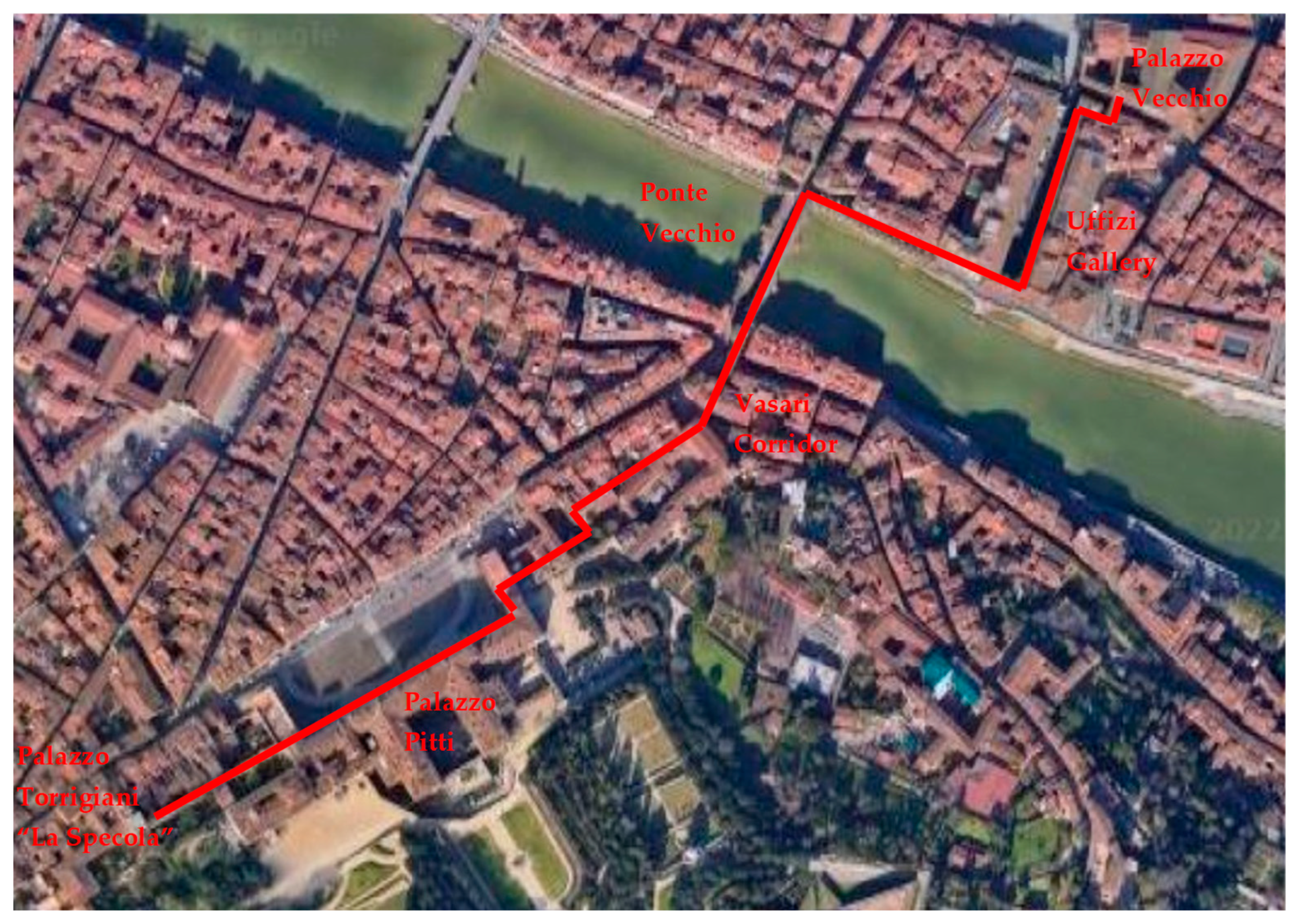

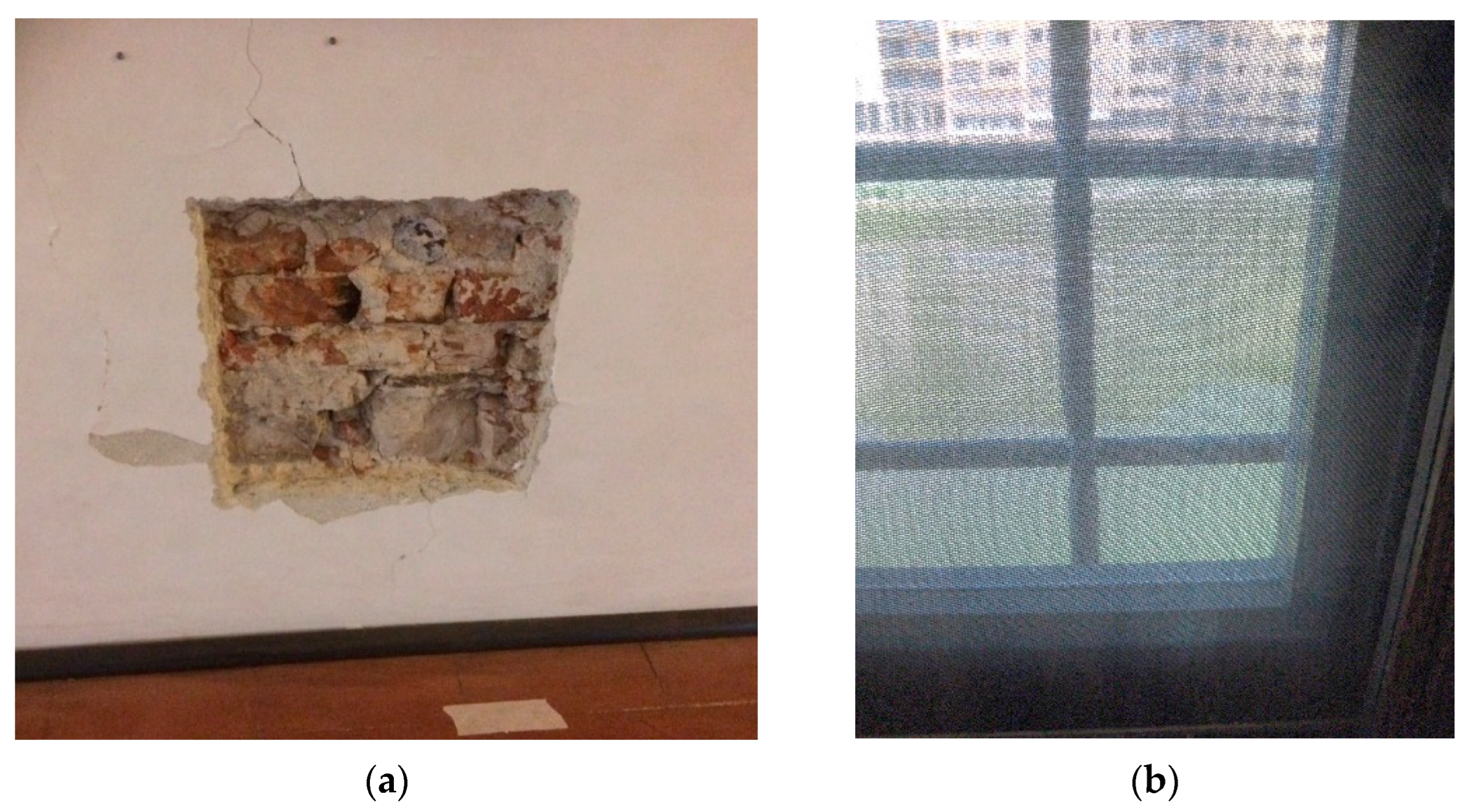
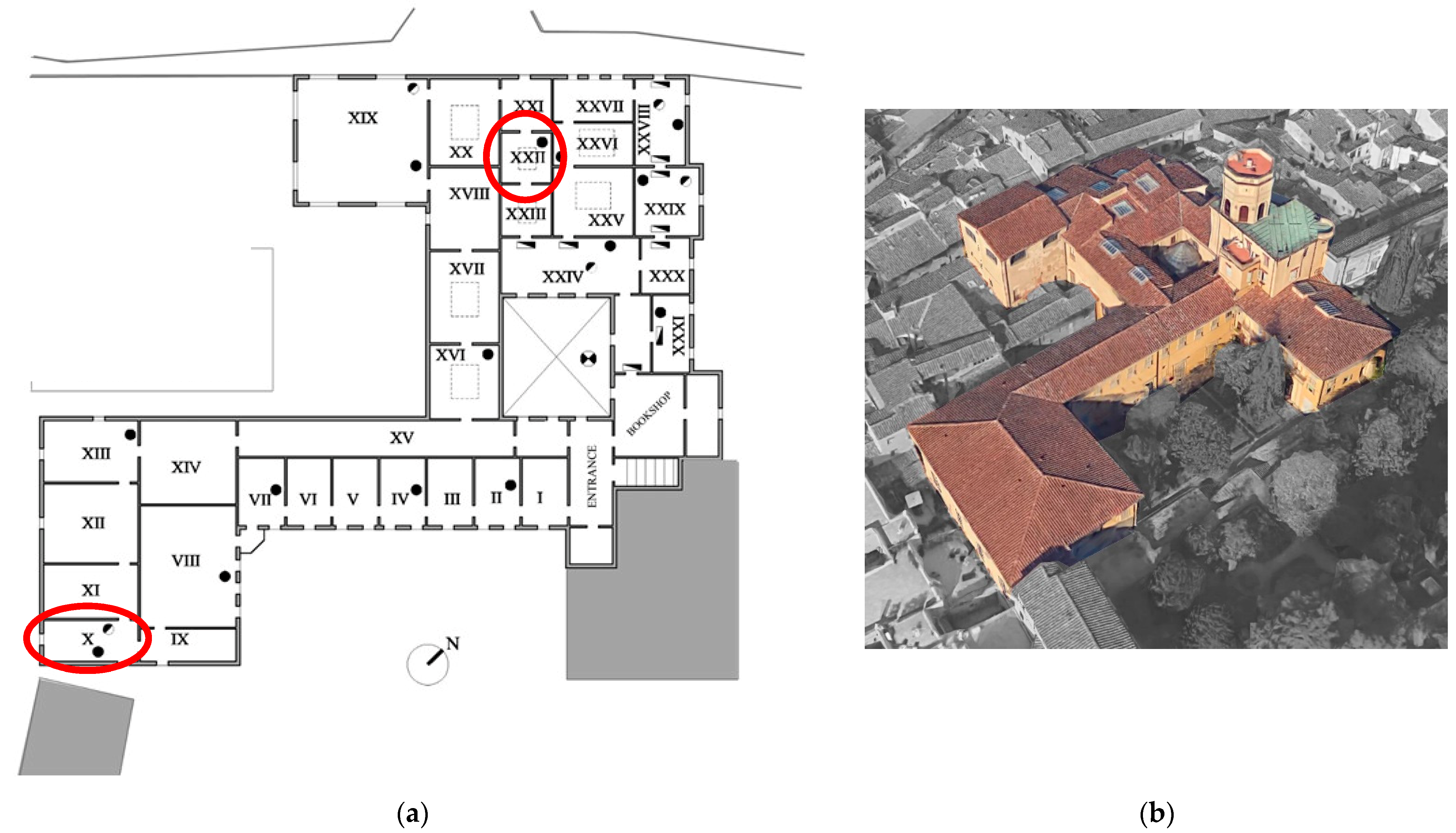

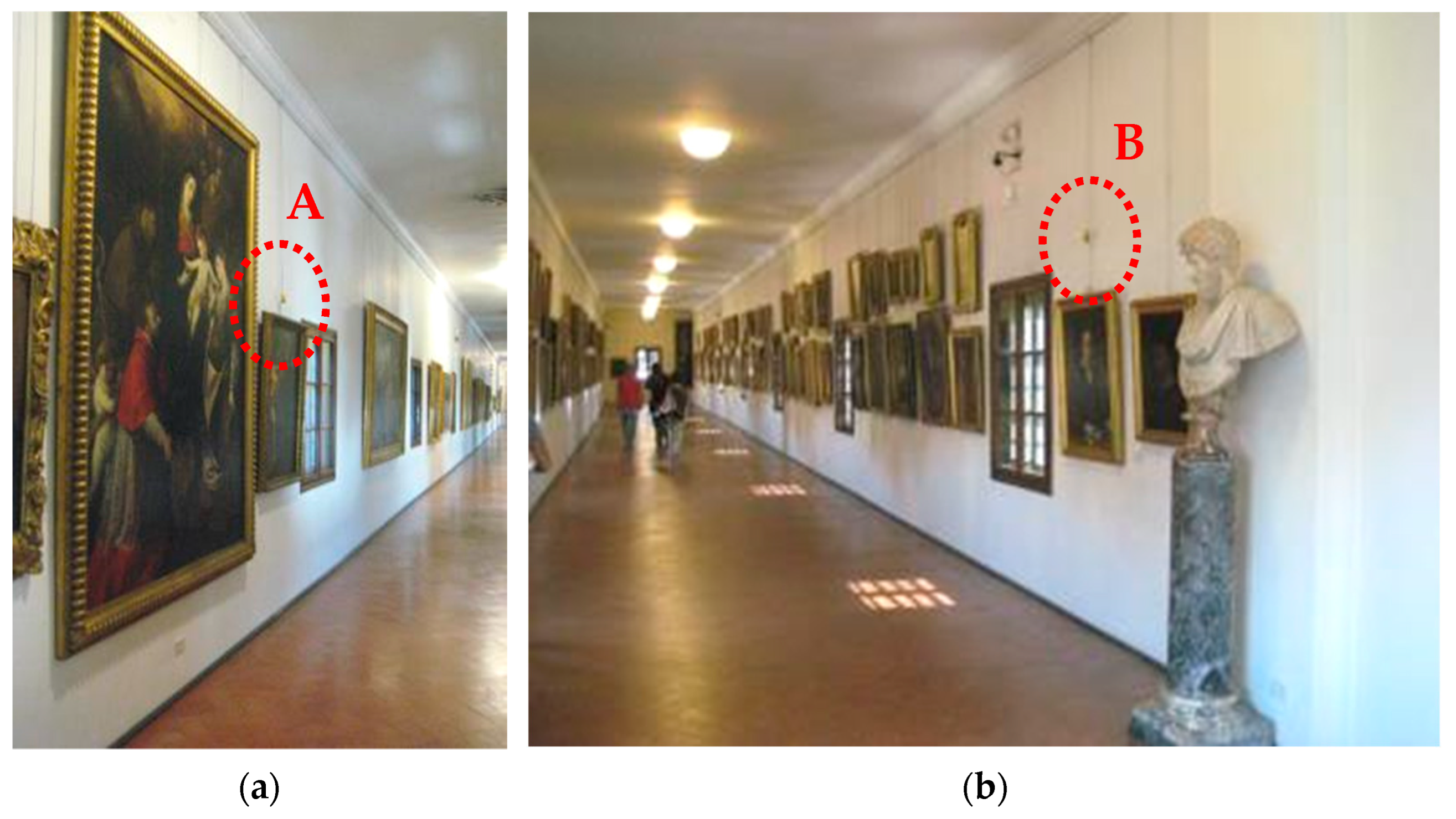
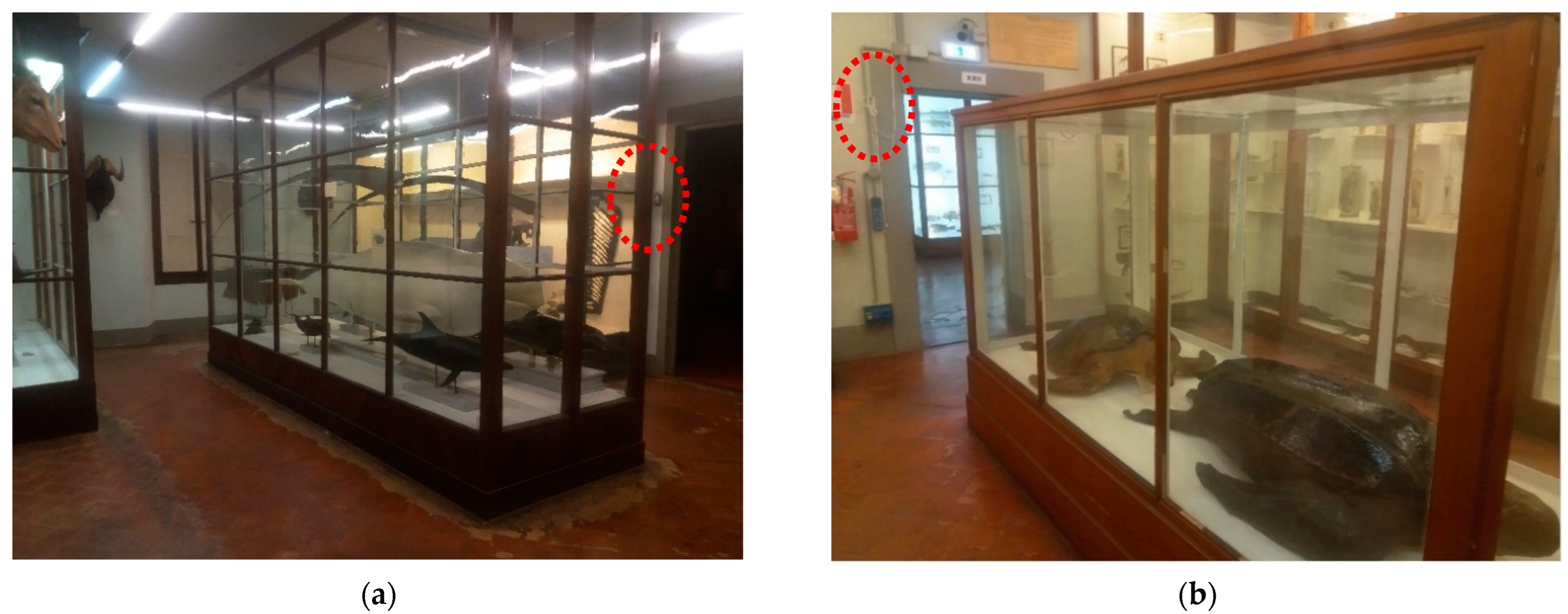
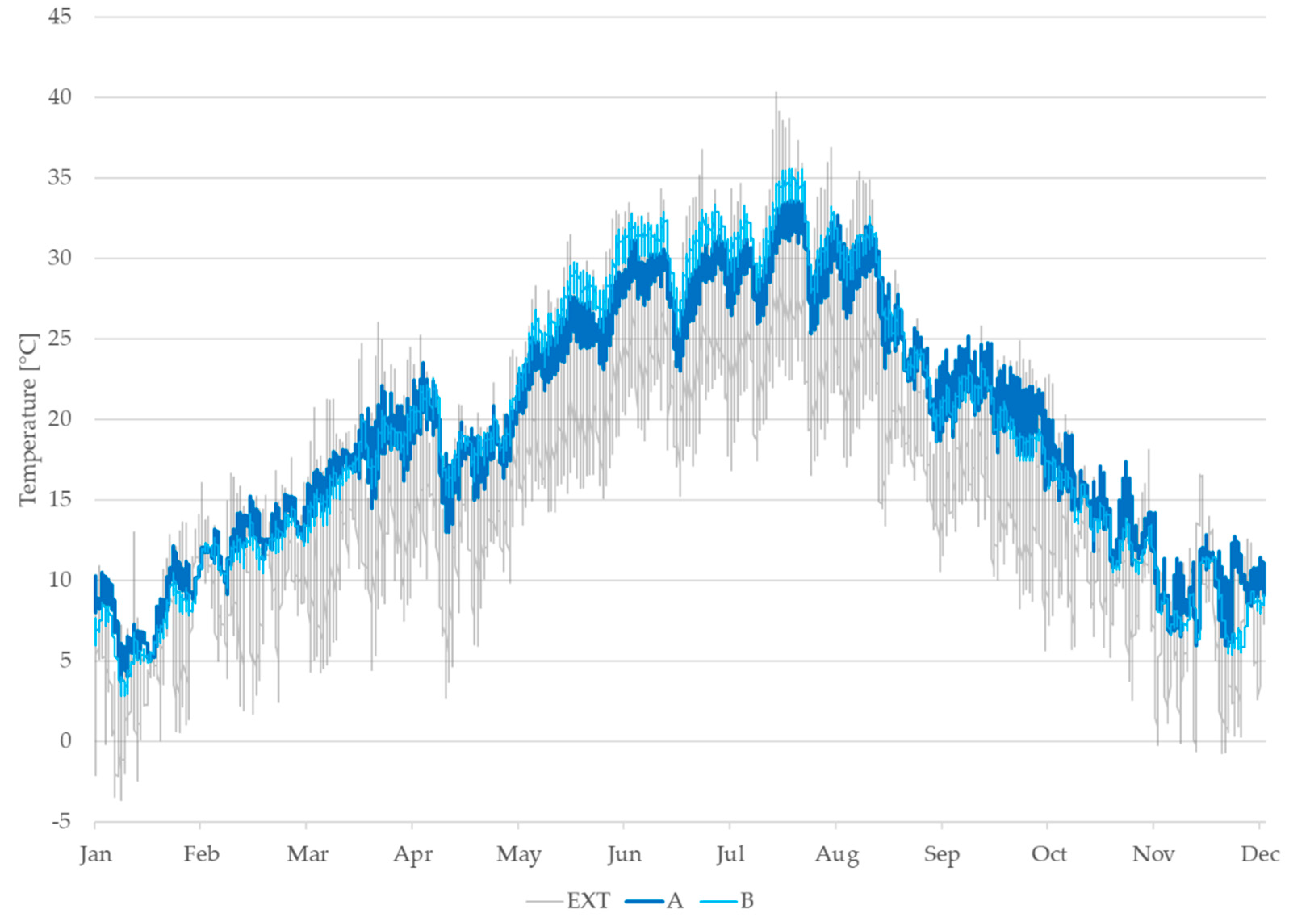


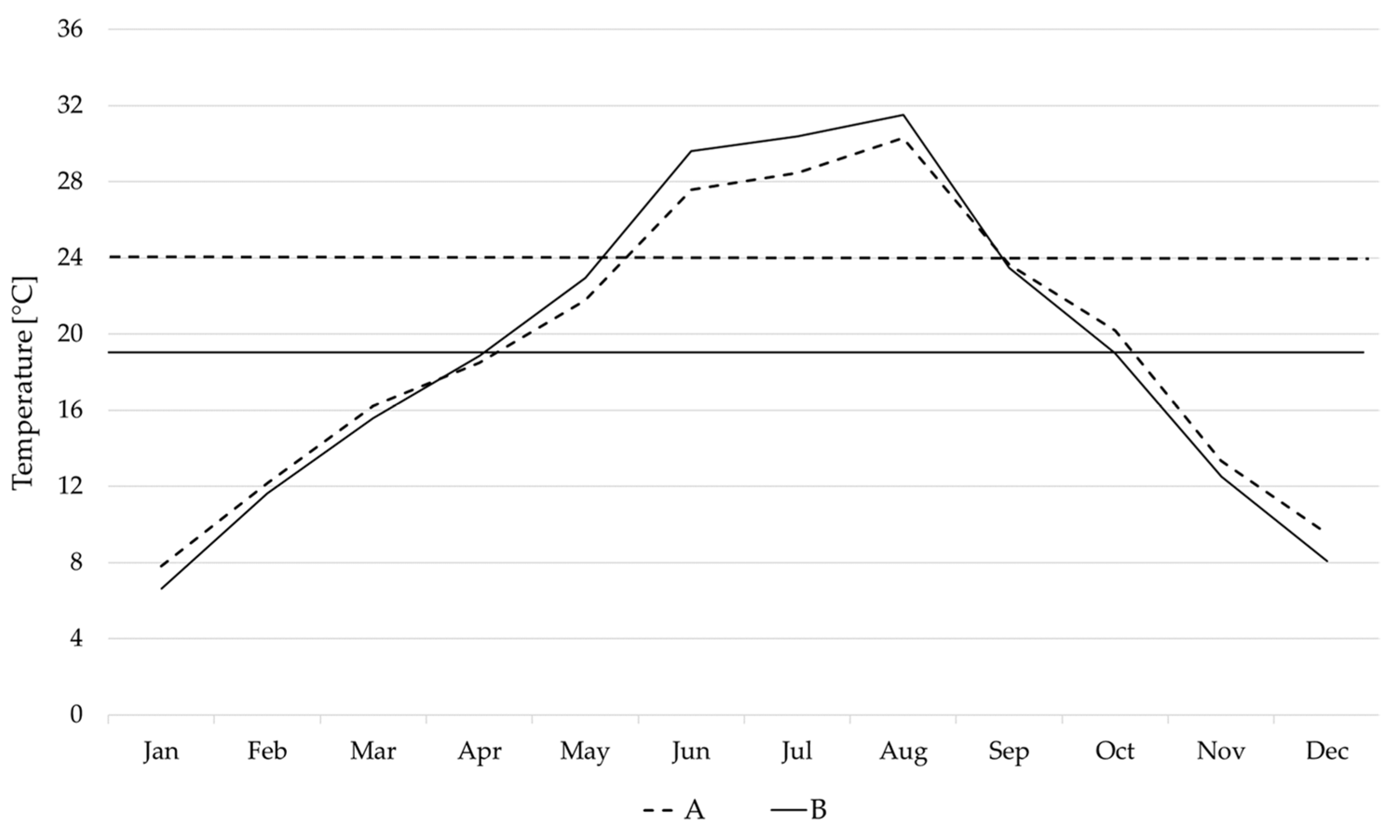
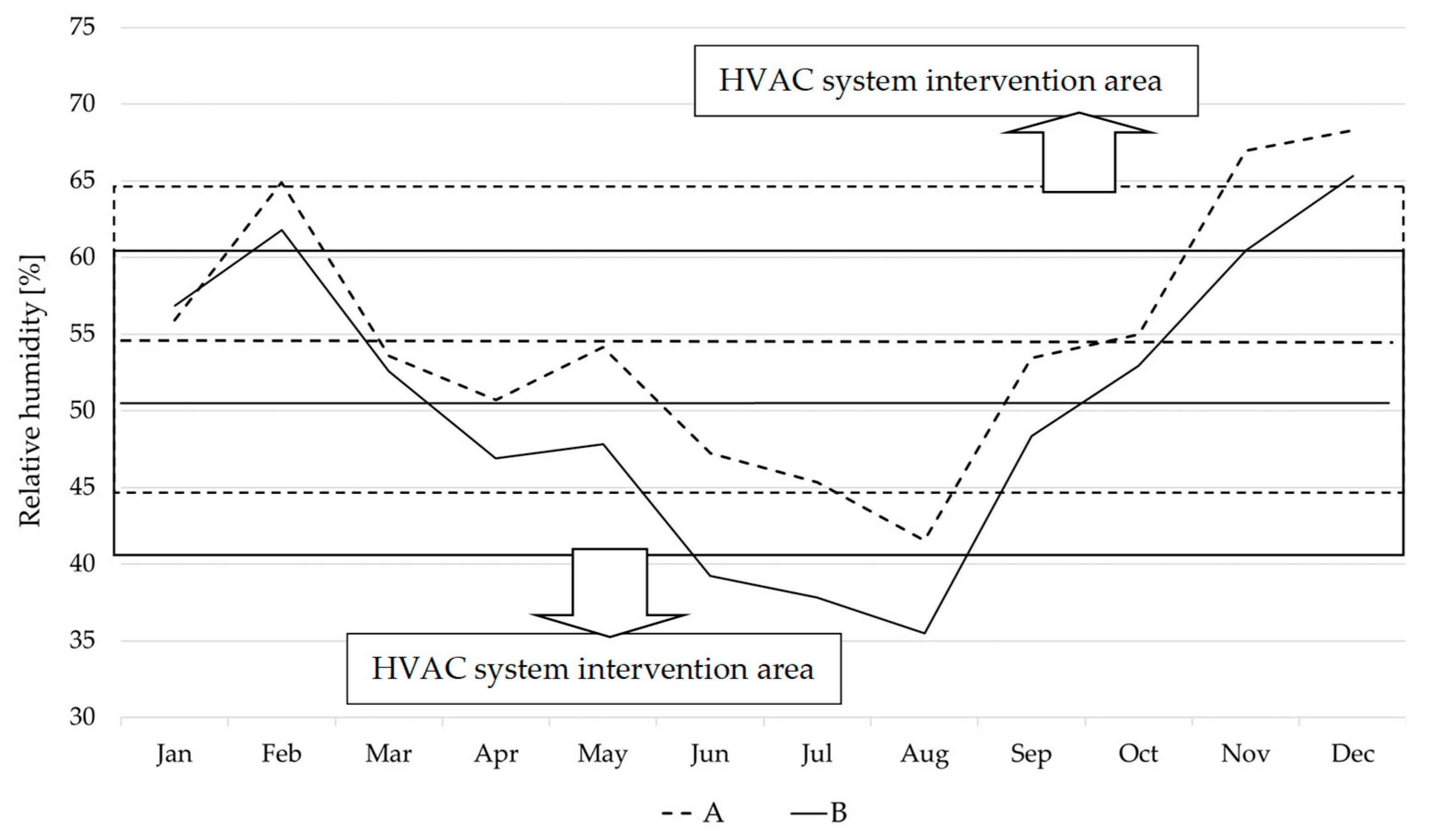

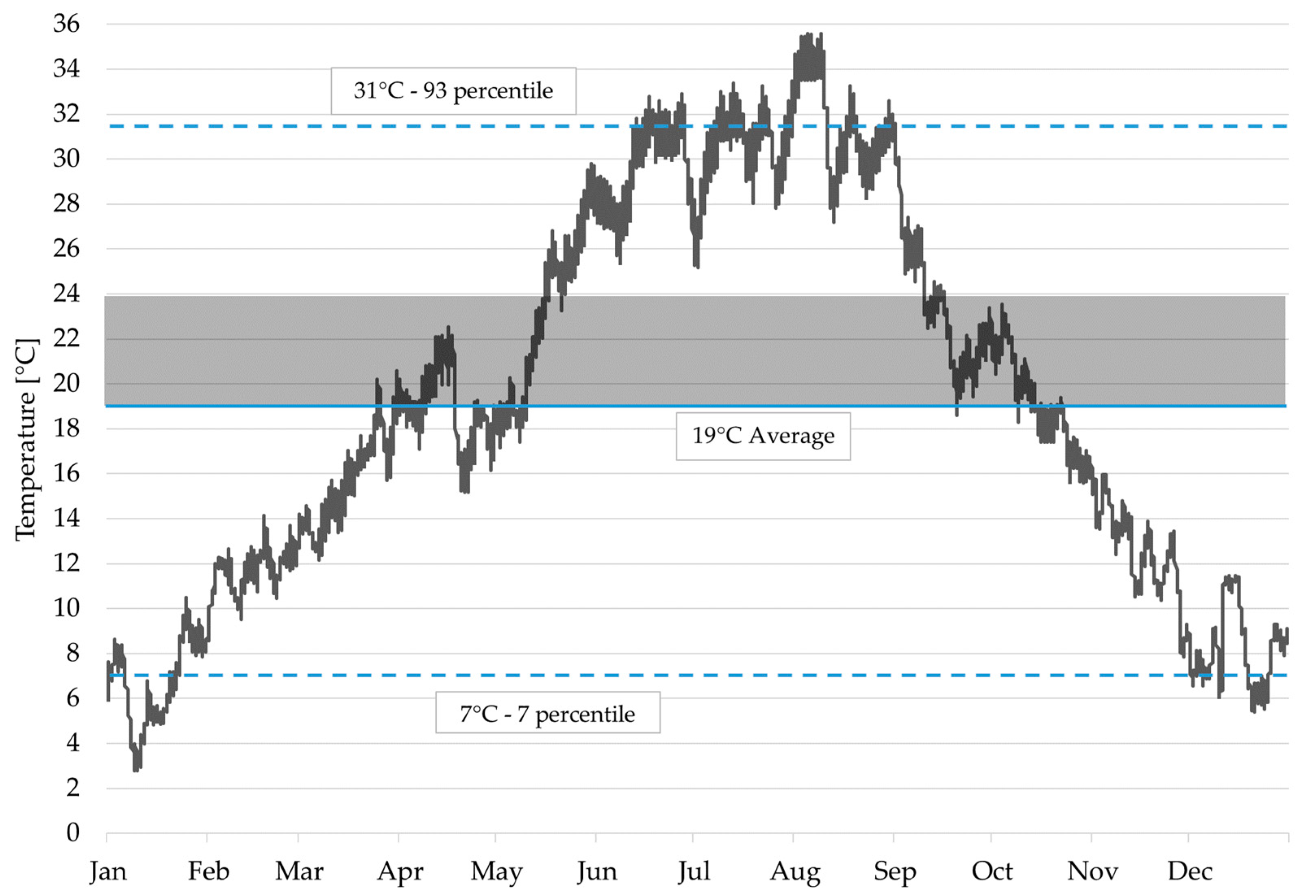
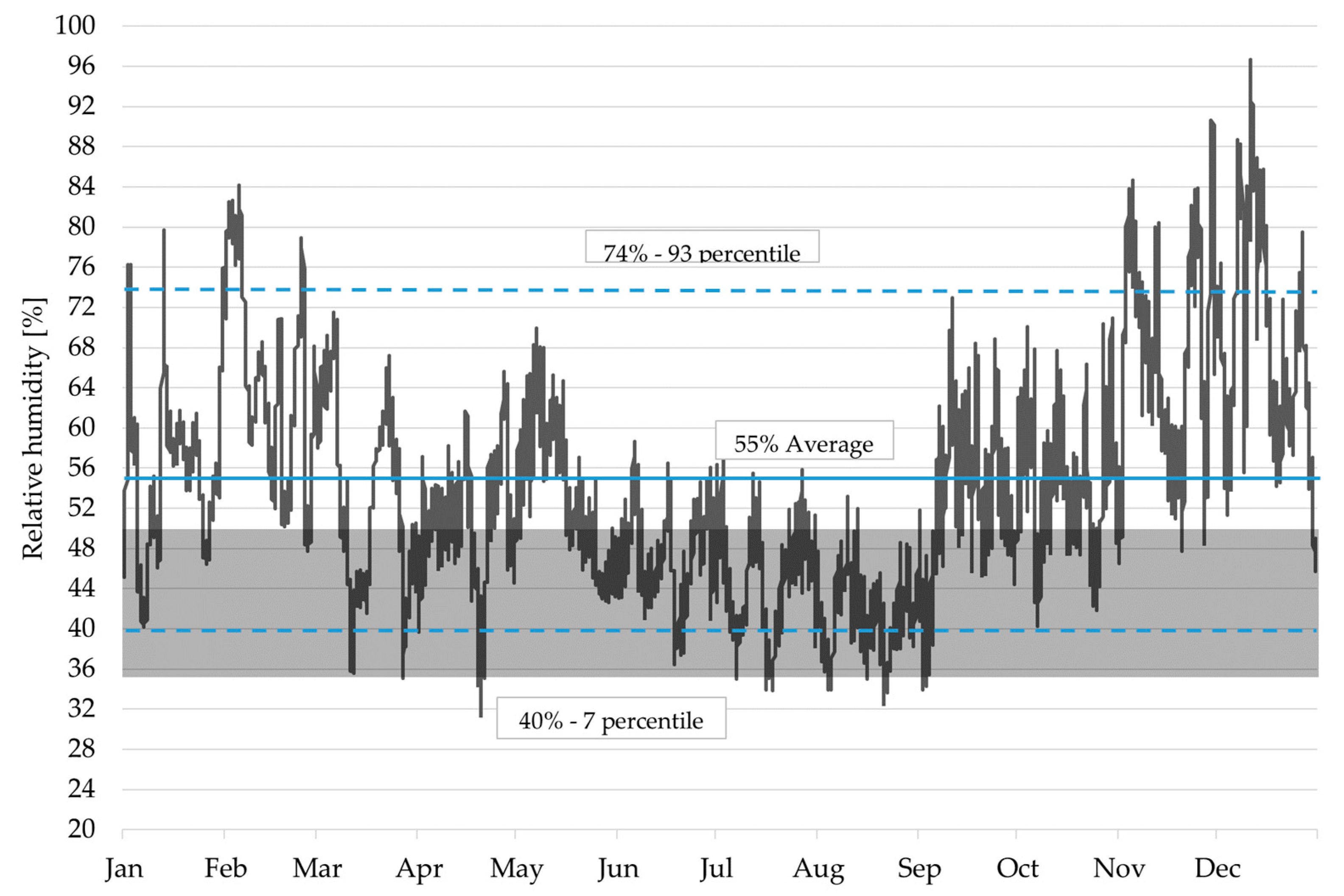
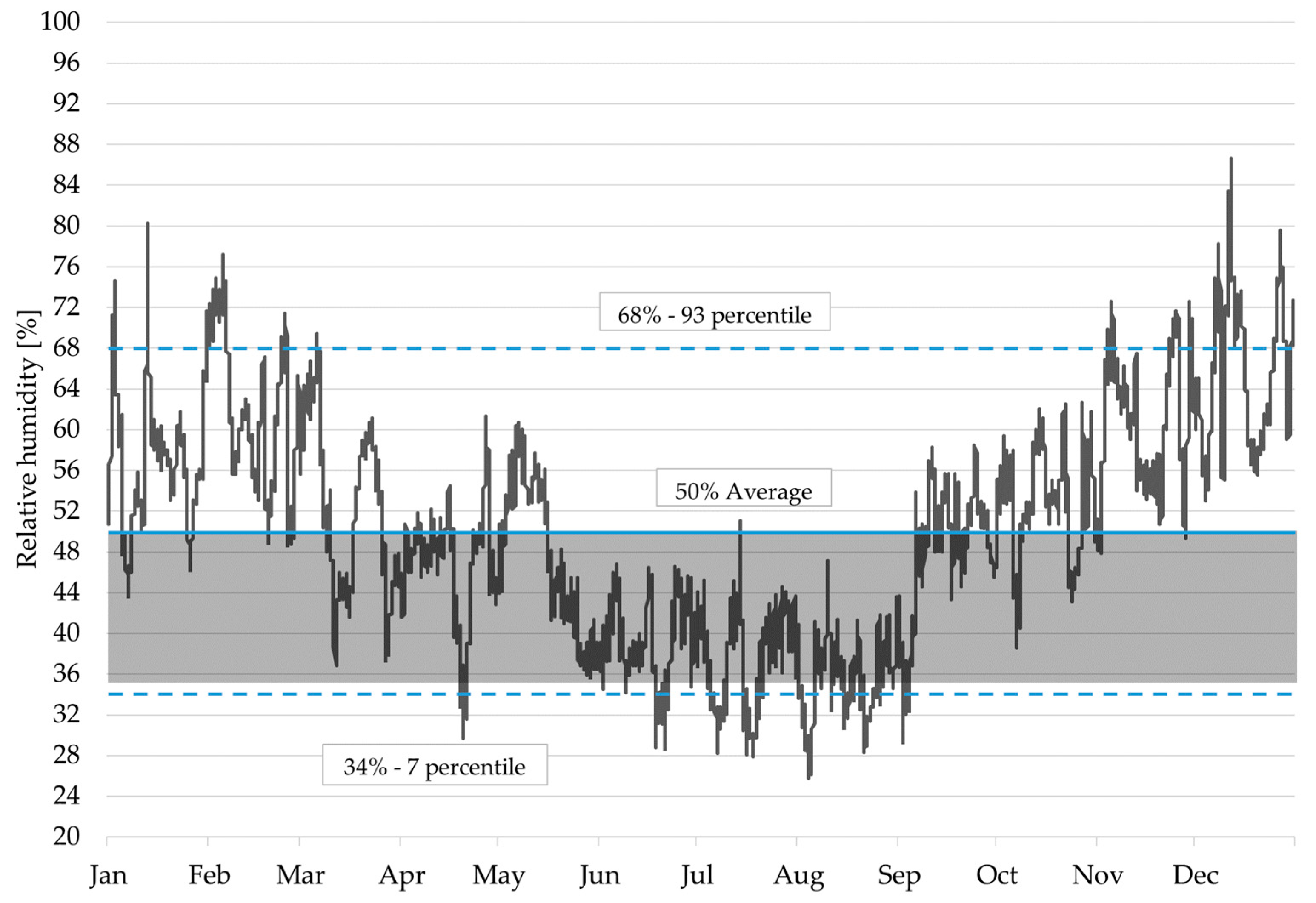
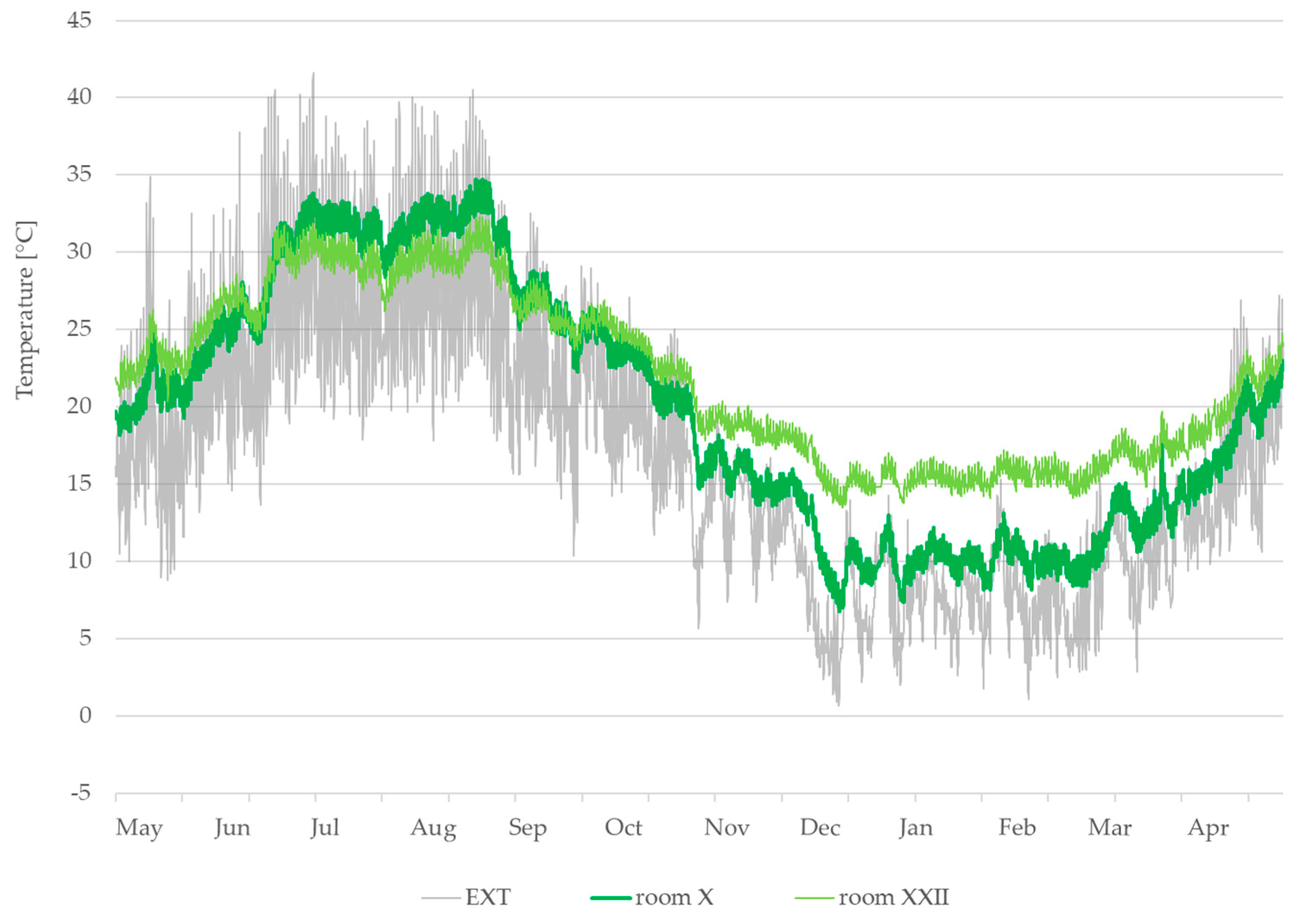
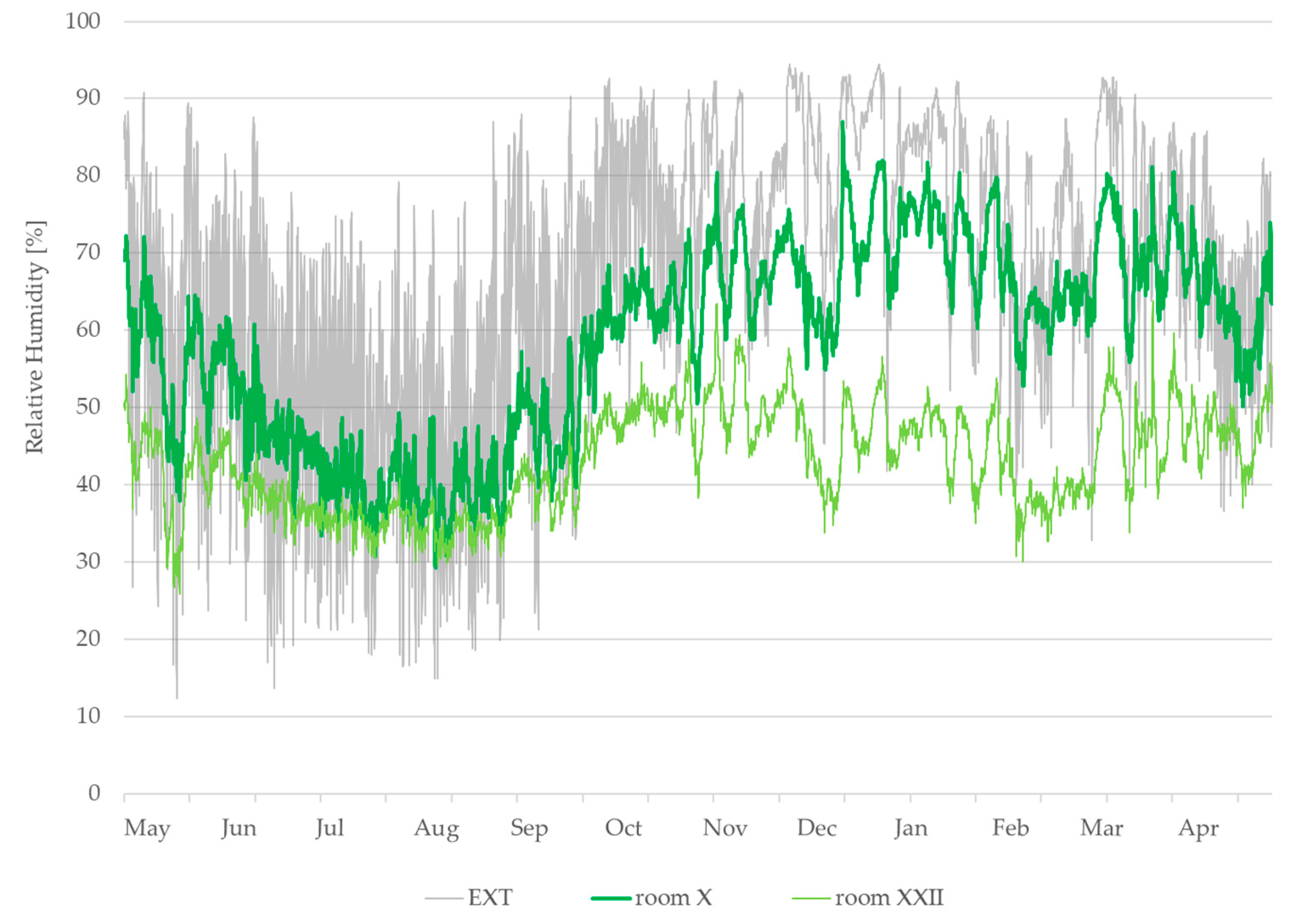
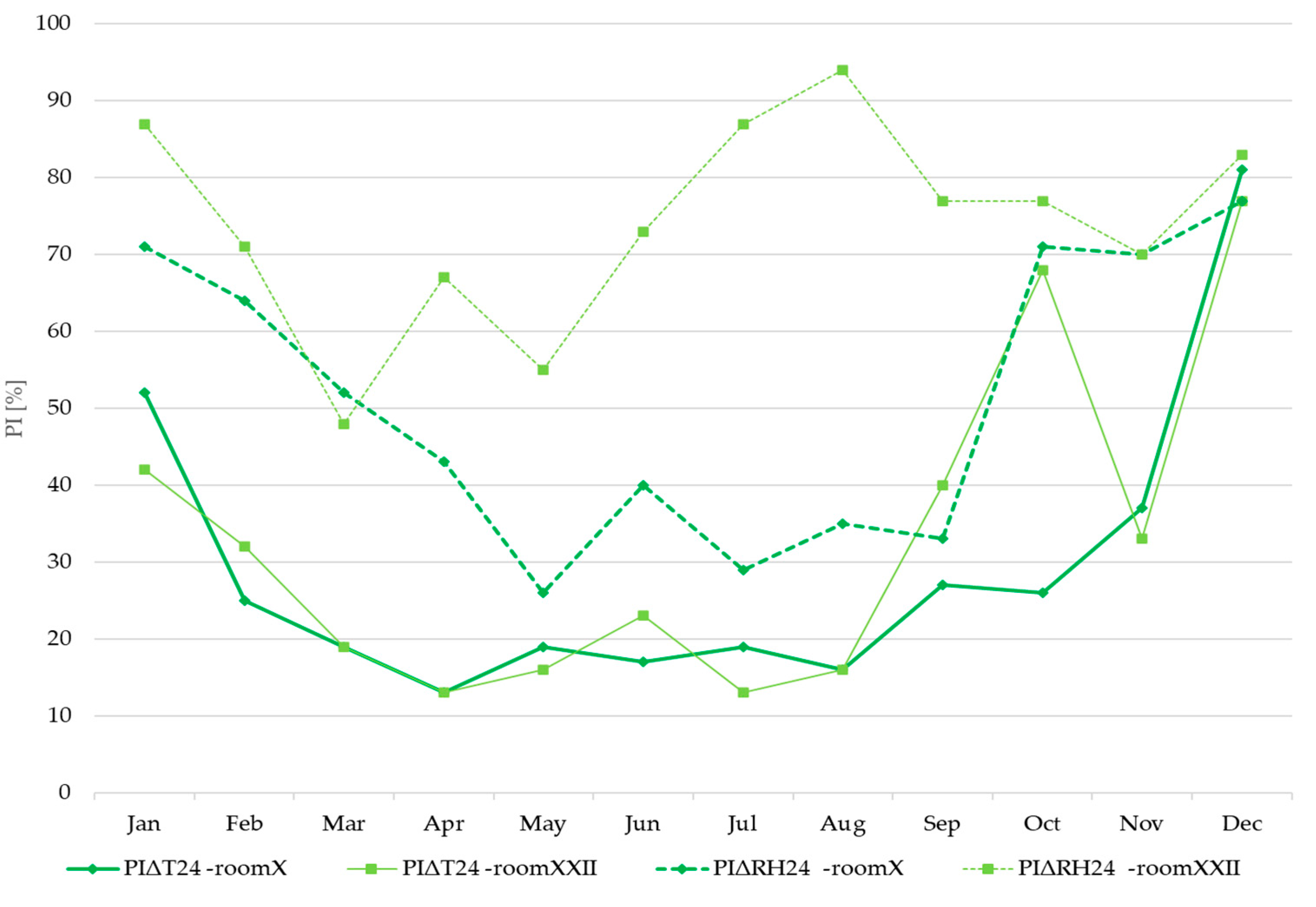
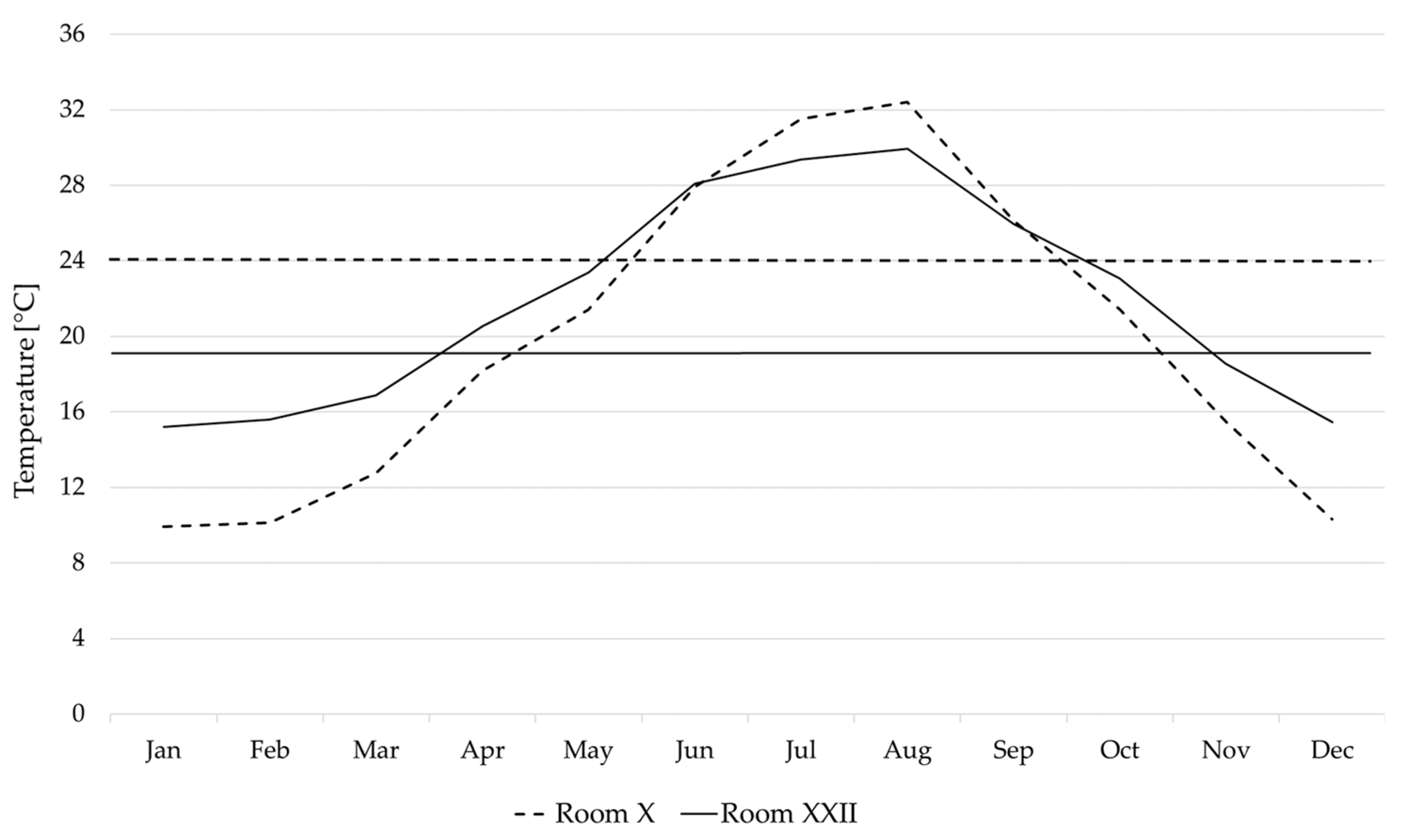

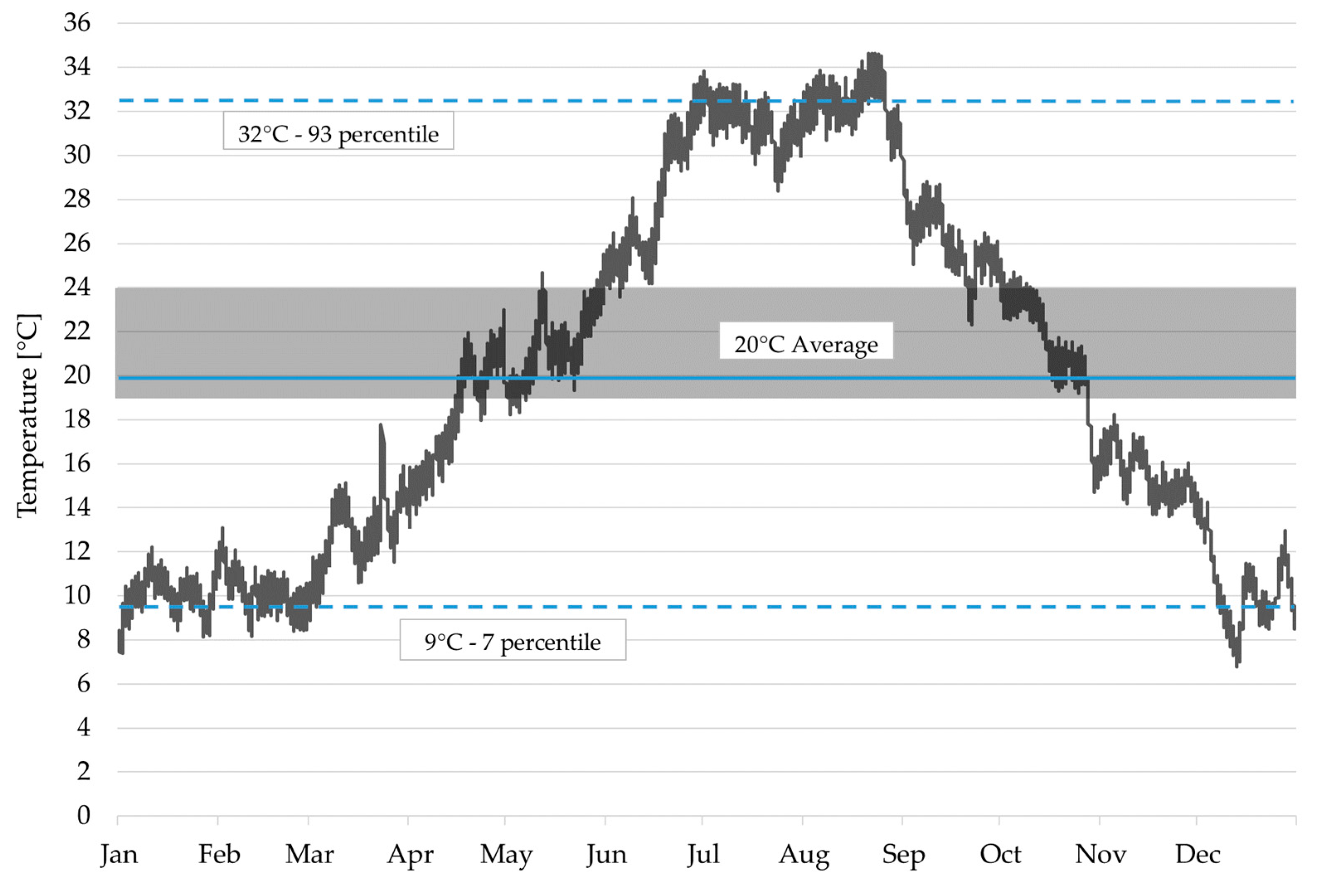
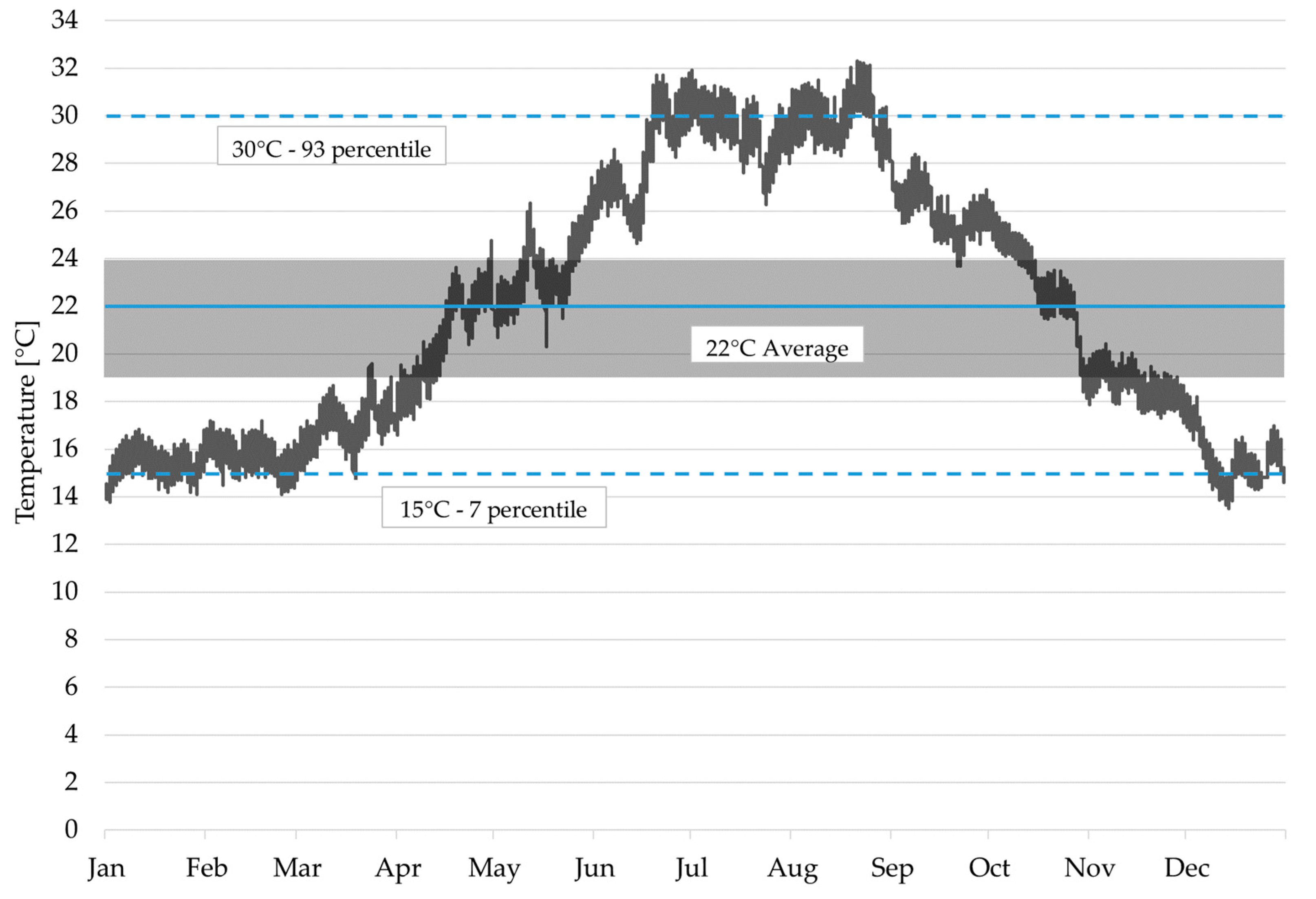
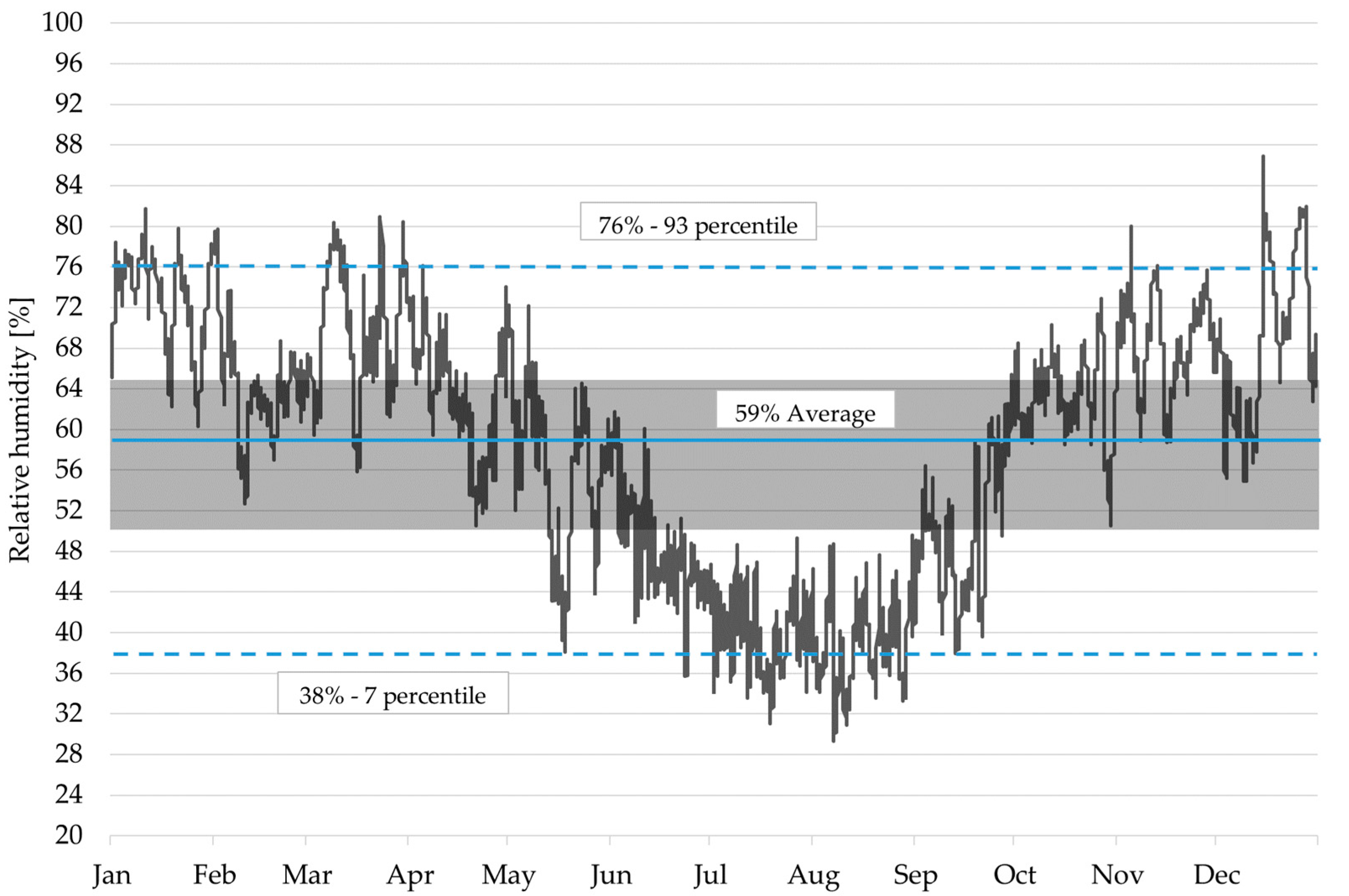

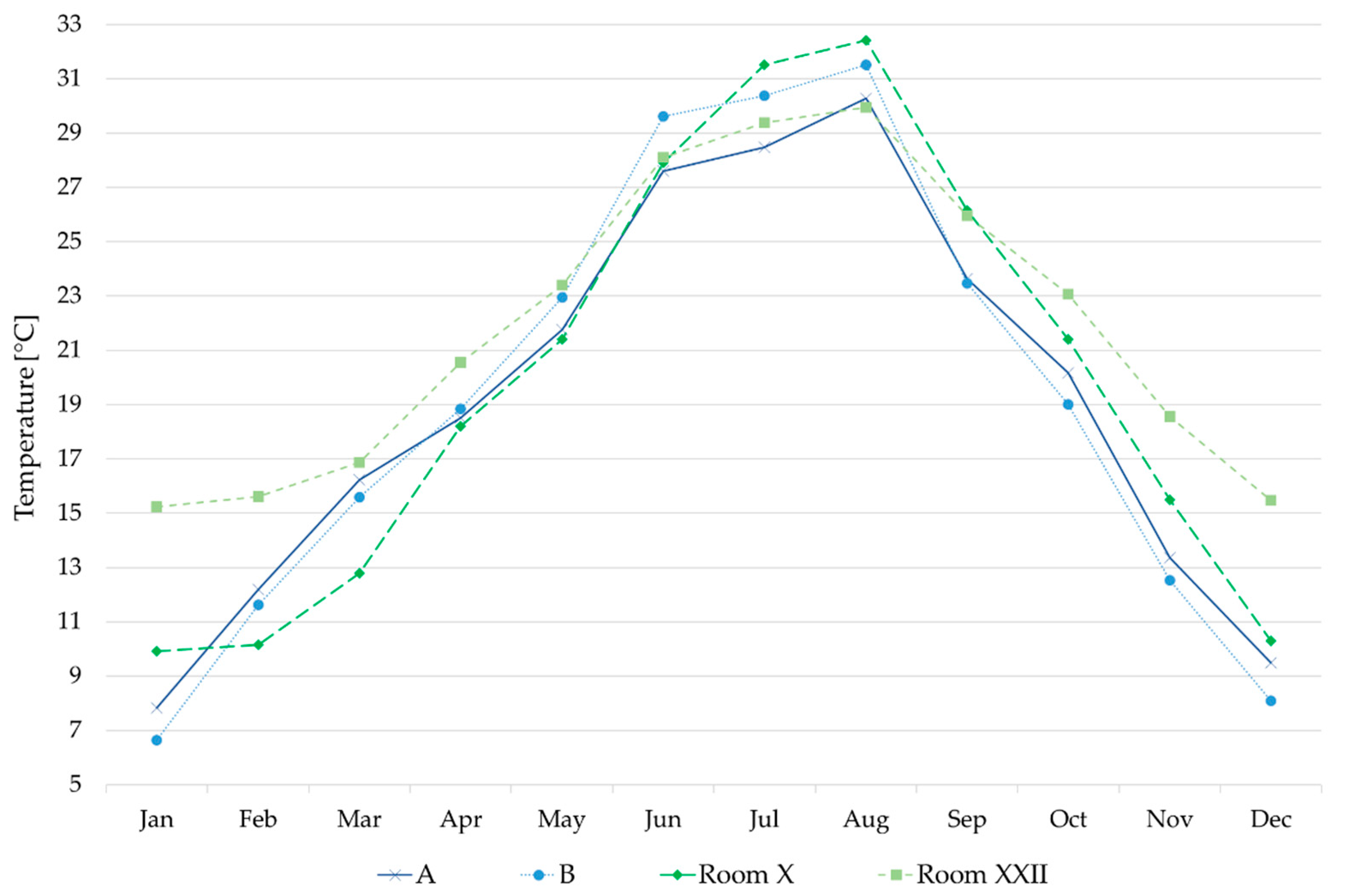
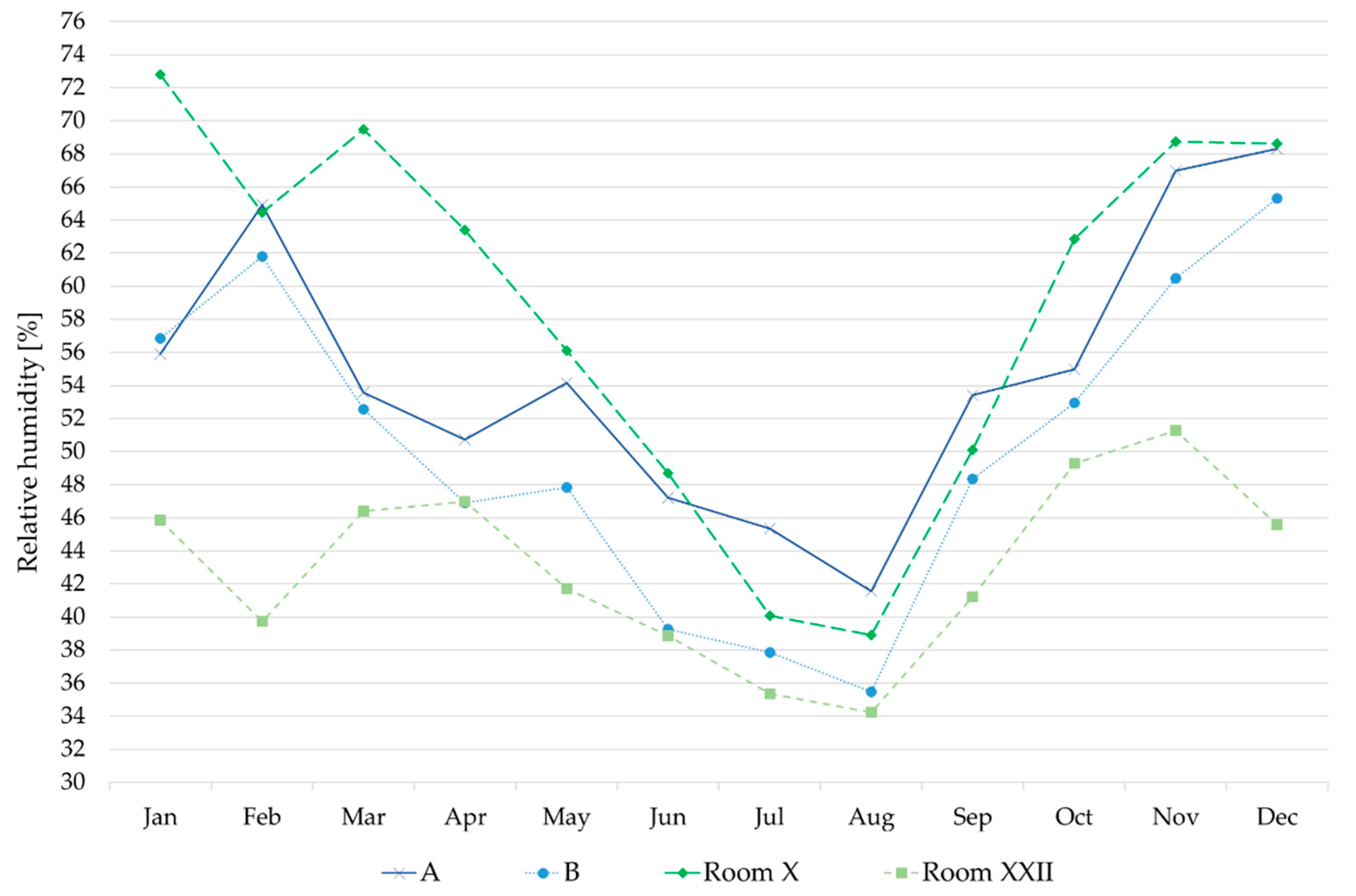
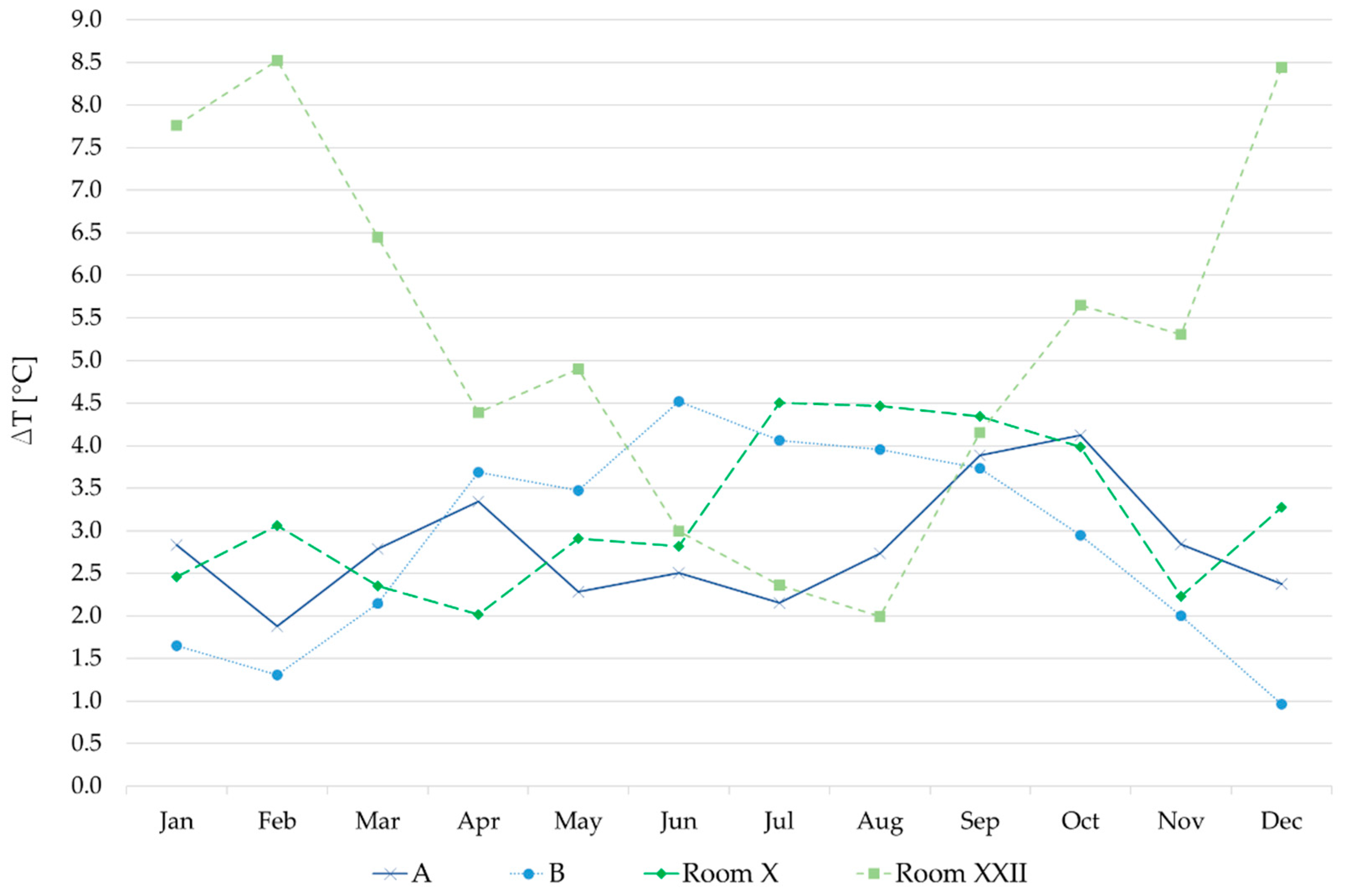
| Parameter | Ponte Vecchio | Lungarno |
|---|---|---|
| External surface * (S) [m2] | 860.90 | 1315.60 |
| External volume (V) [m3] | 1854.20 | 2149.10 |
| Ratio S/V [m−1] | 0.46 | 0.61 |
| Window surface (Sw) [m2] | 74.80 | 39.30 |
| Net floor surface (Af) [m2] | 469.40 | 420.50 |
| Ratio Sw/Af [-] | 0.16 | 0.09 |
| Ratio Sw/S [-] | 0.09 | 0.03 |
| Building Component | Materials | U * [W/m2K] | Yie ** [W/m2K] | g *** [-] | τv **** [-] |
|---|---|---|---|---|---|
| External wall | Internal plaster, solid brick masonry, external plaster | 1.65 | 0.398 | - | - |
| Pitched wooden roof | Truss, double layer of joists, cast concrete, bitumen sheet, tile covering | 1.88 | 1.601 | - | - |
| External floor over vaults brick | Ceramic tiles, cement and sand screed, brick vault, plaster | 1.32 | 0.469 | - | - |
| Double window | Wood frame, single glazing | 2.09 | - | 0.69 | 0.74 |
| Single window | Wood frame, single glazing | 5.78 | - | 0.82 | 0.88 |
| Parameter | Room X | Room XXII |
|---|---|---|
| External surface * (S) [m2] | 75.70 | 41.90 |
| External volume (V) [m3] | 261.00 | 217.00 |
| Ratio S/V [m−1] | 0.29 | 0.19 |
| Window/skylight surface (Sw) [m2] | 3.10 | 5.90 |
| Net floor surface (Af) [m2] | 67.00 | 40.30 |
| Ratio Sw/Af [-] | 0.05 | 0.15 |
| Ratio Sw/S [-] | 0.04 | 0.14 |
| Building Component | Materials | U * [W/m2K] | Yie ** [W/m2K] | g *** [-] | τv **** [-] |
|---|---|---|---|---|---|
| External wall | Internal plaster, stone blocks, concrete filling, stone blocks, external plaster | 0.95–1.53 | 0.043–0.008 | - | - |
| Roof | Wood rafters, brick tiles, roof tiles | 2.99 | 1.960 | - | - |
| False ceiling | Lime plaster, reed trellis | 3.42 | - | - | - |
| Window | Wood frame, single glazing | 4.96 | - | 0.86 | 0.90 |
| Skylight | Metal frame without thermal break, single glazing | 5.83 | - | 0.86 | 0.90 |
| Type of Artefact | T [°C] | ΔT24 [°C] | RH [%] | ΔRH24 [%] |
|---|---|---|---|---|
| “Paintings on canvas, oil paints on canvas” | 19 ÷ 24 | ≤1.5 | 35 ÷ 50 | ≤6 |
| “Organic material in general” | 19 ÷ 24 | ≤1.5 | 50 ÷ 65 | ≤5 |
| Parameter | Point of Monitoring | Average Yearly Value | Percentile | Mean ± 10% * | Reference Value (D.M. 10.05.2001) | ||
|---|---|---|---|---|---|---|---|
| 7 | 93 | −10 | +10 | ||||
| T [°C] | Lungarno (A) | 19.2 | 8 | 30 | - | - | 19 ÷ 24 |
| Ponte Vecchio (B) | 19.2 | 7 | 31 | - | - | ||
| Room X | 19.9 | 9 | 32 | - | - | 19 ÷ 24 | |
| Room XXII | 21.9 | 15 | 30 | - | - | ||
| RH [%] | Lungarno (A) | 54.7 | 40 | 74 | 45 | 65 | 35 ÷ 50 |
| Ponte Vecchio (B) | 50.4 | 34 | 68 | 40 | 60 | ||
| Room X | 58.6 | 38 | 76 | 49 | 69 | 50 ÷ 65 | |
| Room XXII | 43.1 | 34 | 52 | 33 | 53 | ||
| Parameter | Point of Monitoring | Yearly Value (D.M. 10.05.2001) | Yearly Value (Historical Climate) |
|---|---|---|---|
| ΔT24 max [°C] | A | 5.1 | 5.1 |
| B | 4.5 | 4.5 | |
| X | 2.3 | 2.3 | |
| XXII | 2.8 | 2.8 | |
| ΔRH24 max [%] | A | 32.0 | 32.0 |
| B | 23.0 | 23.0 | |
| X | 9.1 | 9.1 | |
| XXII | 7.5 | 7.5 | |
| PIΔT24 [%] | A | 18.0 | 18.0 |
| B | 29.0 | 29.0 | |
| X | 29.0 | 29.0 | |
| XXII | 33.0 | 33.0 | |
| PIΔRH24 [%] | A | 16.0 | 16.0 |
| B | 52.0 | 52.0 | |
| X | 51.0 | 51.0 | |
| XXII | 74.0 | 74.0 | |
| PIT [%] | A | 19.0 | 86.0 |
| B | 15.0 | 84.0 | |
| X | 19.0 | 87.0 | |
| XXII | 19.0 | 84.0 | |
| PIRH [%] | A | 37.0 | 86.0 |
| B | 39.0 | 87.0 | |
| X | 36.0 | 88.0 | |
| XXII | 16.0 | 86.0 |
Publisher’s Note: MDPI stays neutral with regard to jurisdictional claims in published maps and institutional affiliations. |
© 2022 by the authors. Licensee MDPI, Basel, Switzerland. This article is an open access article distributed under the terms and conditions of the Creative Commons Attribution (CC BY) license (https://creativecommons.org/licenses/by/4.0/).
Share and Cite
Sciurpi, F.; Carletti, C.; Cellai, G.; Piselli, C. Assessment of the Suitability of Non-Air-Conditioned Historical Buildings for Artwork Conservation: Comparing the Microclimate Monitoring in Vasari Corridor and La Specola Museum in Florence. Appl. Sci. 2022, 12, 11632. https://doi.org/10.3390/app122211632
Sciurpi F, Carletti C, Cellai G, Piselli C. Assessment of the Suitability of Non-Air-Conditioned Historical Buildings for Artwork Conservation: Comparing the Microclimate Monitoring in Vasari Corridor and La Specola Museum in Florence. Applied Sciences. 2022; 12(22):11632. https://doi.org/10.3390/app122211632
Chicago/Turabian StyleSciurpi, Fabio, Cristina Carletti, Gianfranco Cellai, and Cristina Piselli. 2022. "Assessment of the Suitability of Non-Air-Conditioned Historical Buildings for Artwork Conservation: Comparing the Microclimate Monitoring in Vasari Corridor and La Specola Museum in Florence" Applied Sciences 12, no. 22: 11632. https://doi.org/10.3390/app122211632
APA StyleSciurpi, F., Carletti, C., Cellai, G., & Piselli, C. (2022). Assessment of the Suitability of Non-Air-Conditioned Historical Buildings for Artwork Conservation: Comparing the Microclimate Monitoring in Vasari Corridor and La Specola Museum in Florence. Applied Sciences, 12(22), 11632. https://doi.org/10.3390/app122211632








